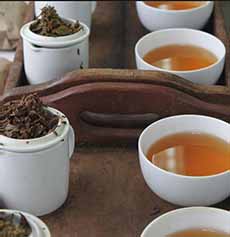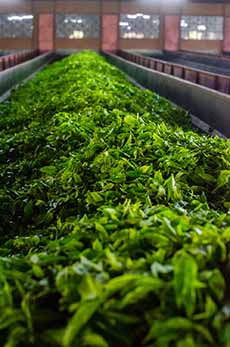Have Some Darjeeling Tea For National Tea Month
|
If you like fine tea, have you tried Darjeeling tea? January is national Hot Tea Month. We’ve written tons and tons about tea, including this Tea Glossary, that explains tea terminology. But celebrating National Tea Month doesn’t mean simply brewing a tea bag from your cupboard. Darjeeling is grown in West Bengal, India in the Darjeeling District, which is situated at the foothills of the Himalayas in the northeast corner of the country. Called “the champagne of teas,”* Darjeeling is the name of the district, the town, and the tea that is produced there. Darjeeling is a medium-bodied style of black tea, renowned for its complex, captivating aromas and nuanced flavors. The liquor, or brewed tea, is much lighter than most other black teas, as shown in photos #1, #2 and #6. While mass-marketed Darjeeling is available in supermarkets around the world, specialty tea shops carry a far superior version: first flush and second flush estate Darjeeling (more about them below). You can see from the descriptions below how the flavors and aromas vary by estate† (similar to how the flavor of the same variety of grapes vary by vineyard). Darjeeling is one of few teas with an origin certification, like the European A.O.C. or D.O.P, attesting that the product was produced in Darjeeling. Since 1999, only teas made at the 87 registered gardens† in the district is allowed to be sold as Darjeeling. Alas, “there is little policing, and counterfeits abound; much more tea is sold as Darjeeling than what those farms could conceivably produce,” say the experts at In Pursuit Of Tea. To add to consumer confusion, in some countries to which Darjeeling is exported, blenders are able to call a any tea “Darjeeling” as long as 51% or more of the leaves comes from the Darjeeling district. So if you want an authentic Darjeeling experience, go to the best purveyors. In Pursuit Of Tea’s Darjeelings include Darjeeling first flush and second flush teas from the finest estates. Their current offerings include: Read the descriptions on each tea’s page (start here). If you can afford it, buy small amounts from different estates to compare. Flush refers to the time of harvest: first flushes are the first picking of the plants, second flushes are a subsequent picking, and so on. In the Darjeeling region: But for connoisseurs, it’s definitely a choice between the first and second flushes of estate teas. While tea was first discovered growing wild some 5000 years ago in China, it is indigenous to both China and India (the history of tea). Tea, like other agricultural products, varies in flavor, aroma and appearance according to its terroir: the type of soil, the elevation (altitude) and the climate and microclimate of the area in which it grows, as well as the weather in each particular season. The processing style of the particular estate also greatly influences the taste and appearance (photo #5). While tea itself dates back thousands of years, Darjeeling tea began its rise to fame some 150 years ago, thanks to Dr. Archibald Campbell. Campbell, a doctor in the Bengal Medical Service, was the first superintendent of the sanitarium town of Darjeeling. A botany enthusiast, he is credited with the introduction of tea cultivation in Darjeeling [source]. As an experiment, he planted tea seeds from the native Chinese tea bush (Camellia sinesis var. sinesis) in his garden at Beechwood, Darjeeling. He was successful in raising the tea plants, such that the British government, in 1847, decided to install tea nurseries in Darjeeling. The first commercial tea gardens were planted in 1852. At that time, Darjeeling was a sparsely populated resort and sanitarium hamlet used by the army and affluent civilians. Tea, a labor intensive enterprise, required large numbers of people to plant, tend, pluck and manufacture the tea. Locals from Darjeeling and from Nepal, just across the border, were recruited. |
|
|
|
The tea grew well in Darjeeling’s high elevation (average elevation 7,000 feet). In that early era of Darjeeling, the British plantation†s marketed it as “the champagne of teas,”* even though the steeped tea was heavy, dark and brisk. In the 1960s, Indian processors began to experiment with producing a lighter Darjeeling tea. They created the modern style, lighter in color and more delicate (more accurately champagne-like). The tea leaves are withered for a long time in heated troughs, and then fired for a shorter time than other black teas. The result is a more aromatic and flavorful tea with a lighter body and more astringency than the original Darjeeling teas [source]. Darjeeling produced the world’s best aromatic teas, and became a profitable venture. Today Darjeeling has 86 tea gardens which produce about 10 million kilograms of tea each year [source]. ________________ *This seems to us to be a clever marketing move. The tea looked nothing in color like champagne (although some other teas are pale gold, like champagne). The closest reason for the comparison is that some people perceive the darjeeling aroma to have a winey aroma, specifically, muscatel grapes. The aroma is delicate and fruity, but there are plenty of wines that could fit this description. However, “the champagne of teas” does sound more beguiling than “the chianti of teas.” †Estates are also called tea gardens and plantations. The term estate is used for single-origin teas that come from a single property (i.e., estate). ‡The muscatel quality in Darjeeling is described as “musky spiciness,” “a unique muscat-like fruitiness in aroma and flavor,” or “dried raisins with a hay-like finish” [source].
|
||








